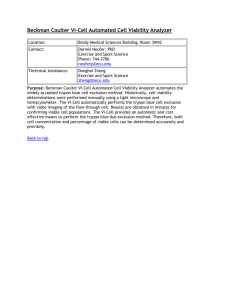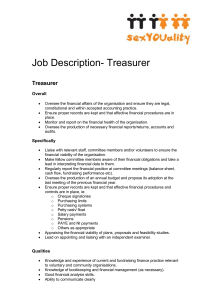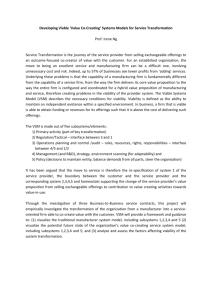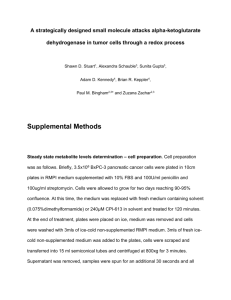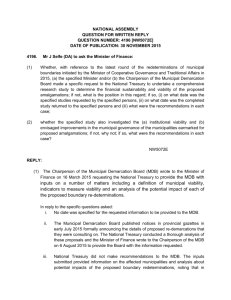Financial viability
advertisement
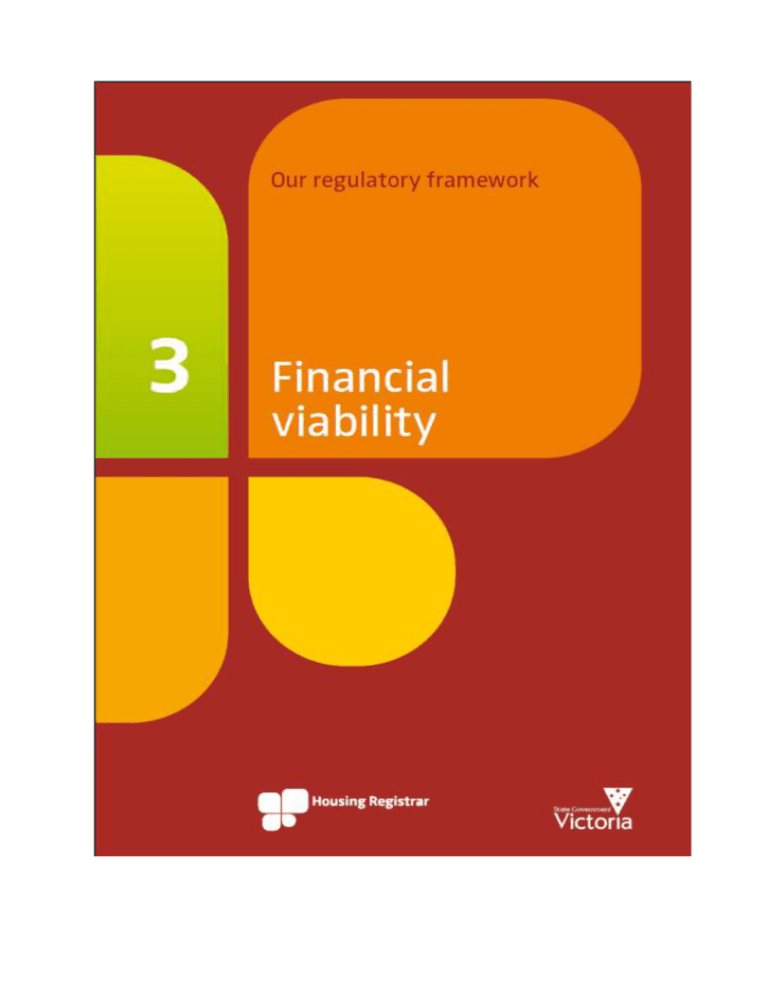
Table of contents 1 Introduction ............................................................................................................................... 3 2 Legislative and other requirements ........................................................................................... 4 3 Introducing our approach .......................................................................................................... 5 3.1 Financial performance report ............................................................................................. 5 3.2 Levels of financial analysis ..................................................................................................... 6 4 Incorporating risk ...................................................................................................................... 7 4.1 Historical and structural factors .............................................................................................. 7 4.2 Operating environment and activities ..................................................................................... 7 4.3 Risk profile.............................................................................................................................. 7 4.3.1 Low level agencies........................................................................................................... 7 4.3.2 Medium level agencies .................................................................................................... 8 4.3.3 High level agencies .......................................................................................................... 8 5 Collection information ............................................................................................................... 9 5.1 Information collected at registration ........................................................................................ 9 5.2 Annual information requirements ............................................................................................ 9 5.3 Periodic reporting ................................................................................................................... 9 6 What we look for – assessing viability ............................................................................................... 10 6.1 Assessing profitability and cash flow .................................................................................... 10 6.2 Assessing short term liquidity ............................................................................................... 11 6.3 Assessing capital structure ................................................................................................... 11 6.4 Overall financial assessment ................................................................................................ 11 7 8 Informing our assessment – other considerations .................................................................. 13 Managing group structures ..................................................................................................... 14 9 Reporting our findings ............................................................................................................. 15 10 Addressing issues from assessments ................................................................................. 16 Summary........................................................................................................................................ 17 Published by the Victorian Government Department of Human Services Level 5, 1 Treasury Place, East Melbourne, Victoria 3002 September 2007 (Updated August 2010) Also published online at: www.housingregistrar.vic.gov.au © State of Victoria 2007 This publication is copyright. No part may be reproduced by any process except in accordance with the provisions of the Copyright Act 1968. Authorised by the State Government of Victoria 1 Introduction Financial viability is part of the regulatory framework series. It outlines our approach to monitoring and assessing this critical feature of registered housing agencies. Our Regulatory Framework provides an overview of how regulation and registration works under the new regulatory system. We now present a series of complementary publications that progress to the next level of detail. Our overall approach to compliance and performance is addressed in another publication in the series. Our regulatory framework 2 Legislative and other requirements Financial viability is one of seven Performance Standards specified for registered agencies by the Minister of Housing, gazetted in August 2005. Section 95 of the Housing Act 1983 (Act) requires registered agencies to comply with Performance Standards. The Victorian state government has invested and is continuing to invest in the growth of affordable housing for disadvantaged Victorians. We must ensure that the investment is managed effectively and affordable housing is available well into the future. It is our role to ensure registered housing agencies are financially viable social businesses. On registration an agency must demonstrate its financial viability. Viability is reviewed in conjunction with the agency’s business plan, its financial policies and procedures, and its financial strategies into the future. The business plan in this context may be a one year plan, a plan across more than one year, or both. Once registered the agency must demonstrate continuing financial viability. Section 105 of the Act requires registered agencies to submit an annual report to us that contains audited financial statements and accounts. This annual report is due within 28 days of the agency’s annual general meeting. In addition to this legislative reporting requirement, we require agencies to submit a financial performance report in the same timeline. This report consists of both historical and forecast financial information. 3 Introducing our approach Financial viability is essentially about being able to generate sufficient income to meet operating payments, debt commitments and allow for growth, while maintaining service levels. Our assessment of financial viability is an integrated process. We review agency audited financial statements, financial performance reports, the business plan, and other information that supports our analysis. Our initial focus in looking at financial viability is an agency’s audited financial statements for the year just ended. As part of our analysis, we assess trends and overall performance of the agency and compare the results with budget or prior year projections. We then analyse the forecasts to ensure the agency remains viable into the foreseeable future. To put these results into a broader context, we must return to the agency business plan. This allows us to be aware of the future plans of the agency at a strategic level, and familiarise ourselves with the agency perspective on its business, growth and the risks that it faces in running its business. Here we are looking for agency insights into its profitability, resource management, growth plans, capital structure, treasury management and liquidity. The business plan provides the roadmap to guide the agency towards its long term goals. The financial plan is a vehicle to track progress and allow the agency to realise its long term goals. While it is imperative to ensure agencies do not operate with excessive levels of risk, we also need to assess the capacity of agencies to grow and develop. For housing associations, this means increasing the availability of affordable housing. Therefore, in the assessment of financial performance, one of our roles is to take a view of the extent to which agencies are maximising the resources available through government grants and leveraging those grants. In summary it is our role to assess the extent to which agencies are financially viable, and operate with an acceptable level of risk, while fulfilling the objective of maximising the availability of affordable housing in Victoria. 3.1 Financial performance report We use a financial performance report to assess the viability of agencies. The report reviews agency performance, using a comprehensive suite of performance measures. Linked with the business plan, the report is a powerful tool for the assessment of agency performance and the impact of future decisions on agency viability. The degree of detail required of an agency in its financial performance report will depend on certain variables. It will vary between agencies and depend on: whether the agency is registered as a housing association or housing provider the range of activities undertaken by the agency the risks that impact on the agency whether the agency has a major capital development or growth program, relative to its size and experience whether the agency has significant borrowings with the potential to affect the agency. The majority of work undertaken to assess agency financial viability is based in the form of a review of documents submitted to us. The nature of that review is determined by the risk assessment of each agency. During the year, we expect agencies to update the Housing Registrar on significant events that impact on financial performance. These include events that have an impact on information previously provided to us, for instance, new capital projects or changes to on-going operations. In terms of financial reporting, the onus is on housing agencies to ensure they provide relevant information that will allow the Housing Registrar to assess financial viability. We also review our own approach and data requirements periodically and seek to simplify data collection where possible. 3.2 Levels of financial analysis The Act recognises two types of housing agencies, housing associations and housing providers. In practice housing associations are larger, more complex businesses, and companies limited by shares or guarantee. In essence, the distinction between associations and providers represents a risk based approach at a strategic level. As such we use separate financial performance reports for housing associations and housing providers, which reflect the differing risk profiles. To be a registered housing association, an agency must have a sustained capacity to undertake initiatives to grow affordable rental housing, using a mix of government funds and private sector investment. With extensive housing portfolios and a level of commercial borrowings, housing associations must undertake long term financial evaluation of capital programs and their impact on agency operations. Therefore, the financial performance report for housing associations is a comprehensive report, which includes information related to: capital programs, including program scope and timing financing of the programs, for example internal sources, commercial debt, government grants or philanthropic contributions loan commitments and covenants, including the agency’s capacity to repay debt working capital management maintenance and asset condition accounting and financial treatment of grants, housing asset valuation, and depreciation of housing assets. The housing providers represent a diverse range of housing agencies, many catering for a specific tenant group or locality. In general, housing providers manage government owned rental housing stock; however some providers have relatively small numbers of their own stock. Regulation (financial viability) for housing providers is shaped by the type of activities undertaken and risks faced by the agency. As such, housing providers are required to fill in a medium or low level financial performance report. Some of the key areas we look at include: non housing activities undertaken by the agency maintenance of agency stock agency’s approach to growth, in terms of better service provision and capital developments the utilisation of grants, operating surpluses or donations to maintain or improve the level of service for housing providers that own housing assets, we look at the underlying responsibility for maintenance and capital works to sustain that asset. 4 Incorporating risk An organisation’s financial position and ongoing viability are influenced by its history, operating environment and planned future activities. We take account of these in our risk based approach. 4.1 Historical and structural factors A number of structural factors can impact on our assessment of an agency’s financial position and performance: age of the agency’s housing stock regulatory history number and geographical spread of housing units existing external debt levels type of agency (association or provider) level of involvement in support housing activities level of involvement in diverse activities (and trends in that involvement) level of involvement in contract income, rather than asset based activities. In analysing the potential impact of these factors, we consider composition, experience and effectiveness of board and management, together with a track record of dealing with external or internal problems. We take account of all knowledge we hold as a result of regulatory activities, not just with reference to financial viability, but also through our review of the Performance Standards, primarily governance and management. The degree of commercial orientation and financial sophistication of management are relevant to the ability of management to execute strategies and plans. This also applies to accounting and management information systems, together with planning, budgeting and control systems used to detect and respond to changes in the business environment or a deteriorating financial position. We look for evidence that management is aware of key assumptions and business drivers, and has conducted sensitivity and scenario testing as part of a strategy for managing the risks to achieving organisational objectives. 4.2 Operating environment and activities In the delivery of different outcomes, registered agencies face many challenges inherent in their operating environment. The risks faced by an agency vary according to financial structure, activities, geographical location and other factors, and can include: delivering new homes (including growth areas) Office of Housing’s partnering agenda social housing sector efficiency targets compliance with rent affordability criteria differential inflation rates, particularly in respect of maintenance and staffing costs developments in the residential property market other support service programs. 4.3 Risk profile We have developed a three level model for describing the complexity of a registered housing agency’s business, and the inherent potential degree of risks they face in their operating environment. This reflects our judgement that simply separating the agencies into their registration categories of associations and providers does not adequately translate into on appropriate model for the level of regulatory scrutiny required. 4.3.1 Low level agencies Low level agencies are those classified as providers whose businesses are predominately housing focused or numbers of properties managed are very small. We conduct a financial health check on low risk agencies based primarily on the financial performance report (two historical and three forecast years) and audited financial statements. To be considered low level, the probability of operational risk should be low due to a stable operating environment and satisfactory governance. The potential impact of problems should also be minimal. Issues that impact on agencies include: agency size level of growth forecast, including agency capacity to handle growth, and forecast use of interest bearing debt to finance growth changes in agency operating environment. 4.3.2 Medium level agencies The level of financial detail required of an agency is commensurate with its risk profile. Therefore, we undertake a more detailed assessment of medium level housing agencies. Medium level agencies are classified as having more diverse operations and may own a portfolio of properties. The financial performance report incorporates: corporate overhead allocations for multiple operating segments an affordable housing segment for agency owned properties a longer term reporting requirement (three historical and five forecast years) a greater range of trend and financial ratios. Medium level and high level agencies are required to disclose supplementary financial information to demonstrate their depth of analysis. This may include supporting workings, forecast assumptions, models and other planning tools used to derive the financial performance report. This extra information allows us to develop a clearer understanding of the underlying assumptions and drivers of performance. 4.3.3 High level agencies High level agencies have expectations of significant growth with the financing of a proportion of this growth through external sources including private debt. This results in a higher risk profile than housing providers. High level agencies have the highest disclosure requirements. The financial report consists of four years of historical and fifteen years of forecast information. There is a requirement for long term financial assessment with closer on-site interaction with the finance director and agency staff as appropriate. Agencies in this category are also required to submit their half yearly financial statements to the Housing Registrar. For these agencies the potential impact of failure is high due to size, complexity and level of development. This is demonstrated by some or all of the following: obligations arising from capital projects loan covenants and development timelines complexity from loan arrangements and structures consideration given to organisational capacity and risk management. We expect these agencies to implement an asset strategy including asset management and maintenance. 5 Collection information Each year, registered agencies are required to submit their business plan, financial performance report and signed copy of audited financial statements and notes to the accounts, together with the auditor’s declaration and agency notes. Agencies are first required to demonstrate financial viability during the registration process. 5.1 Information collected at registration At registration we collect copies of the past three financial years’ audited statements as well as a financial performance report. We also collect information about: financial management and financial policies detailed budget for the current year tracking against current budget approach to growth and funding non housing activities undertaken by an agency. For agencies seeking to be registered as housing associations, we also require a financial plan setting out a planned development program that includes impact analysis of the development program (may be 25 years or more). Housing agencies are requested to submit their financial performance reporting in an electronic format. The information collected in our financial performance report enables us to analyse agency viability. The report also allows agencies to carry out self analysis of financial performance and viability. Agencies can: review performance ratios calculated automatically in the financial performance report experiment with different assumptions, giving the agency an indication of the sensitivity of results to assumptions provide comments to assist in the interpretation of trends in agency performance. 5.2 Annual information requirements Once an agency achieves registration, financial viability is assessed annually as part of the annual review process. To inform the annual review, an agency submits a number of reporting requirements. Business plans are submitted during August and audited financial statements and a financial performance report are submitted within 28 days of an agency’s annual general meeting. In addition, details of any significant variations to agency financial policy should be provided to us. We review the business plan alongside the audited financial statements and financial performance report, and make a judgement about agency viability. 5.3 Periodic reporting High level agencies are required to submit periodic reports to supplement the financial information from the annual review process. Periodic reporting allows for the collection of more timely information with comparisons of actual performance against expectations. This interim information allows us to monitor ongoing financial viability. Half yearly reports are a form of periodic reporting and contain information on: current project timelines project risk assessments significant variances against budget upcoming projects other material information. 6 What we look for – assessing viability In assessing financial viability, we are concerned with both short term and longer term viability. We largely assess the financial viability of housing agencies from information generated by the financial performance report. Key dimensions we consider are outlined below. 6.1 Assessing profitability and cash flow Longer term financial viability concerns the ability of housing agencies to meet future financial obligations as they fall due. This ability is closely linked to an agency’s profitability and cash generation over the asset cycle together with the management of long term debt. Although registered agencies are not for profit entities, the profitability of an agency is important from a number of perspectives, including to: provide a buffer against future adverse circumstances allow for the long term replacement/refurbishment of housing stock fund growth. Each agency’s profitability is affected by its environment, condition of housing stock, growth projections, client profile and their requirements. Given the potential for significant discrepancies between accounting profit and cash flows, we also assess agency cash flow position in detail. We note that analysis of cash flows are likely to provide indicators subject to greater volatility due to the impact of capital expenditure and movements in working capital. Consequently, our analysis is focused on trends and average movement over a combined number of periods. We also review the trends before and after the removal of capital grants and non recurring items. In analysing profitability and cash flow, we focus on: sustainability – the extent to which historical cash flows and profits are sustainable, and not reliant on non recurring items or capital grants growth – the potential for growth and also the impact of growth on profitability and surpluses stability – the extent to which cash flows and profits provide a stable base for growth and debt service. These are shown in Table 1 below. Table 1: Ratio and indicators calculated in the financial performance report Indicator type Stability and growth of earnings Revenue and expense analysis Efficiency measures Cash flow measures Examples EBIT EBITDA Net profit Return on assets % income from rent Revenue per property Social housing expenditure per property Maintenance of properties Staff utilisation and efficiency Housing stock owned and/or managed Operating cash flow Internal financing ratio Rationale Provides insight into the stability of earnings and agency ability to generate surpluses on an ongoing basis. Indicates the sustainability of an agency’s revenue and expenses. Gives an indication of agency capacity for growth and resource utilisation. Analysis of operating cash flow provides an indication of the agency ability to generate cash. 6.2 Assessing short term liquidity Our assessment of agency short term financial viability is based on data submitted in the financial performance report. We focus on whether the agency is able to meet short term commitments as they fall due. We also consider whether organisational problems foreshadow financial concerns or might lead to loan covenants being breached. Liquidity measures are shown in Table 2. Table 2: Liquidity measures Indicator type Immediate liquidity Examples Quick ratio Amended quick ratio Short/medium term liquidity Tenancy liquidity measures Refinancing risk Net assets Arrears Bad debts Vacancy/voids Rationale Provides an indication of agency ability to meet short term liabilities as and when fall due. Provides an indication of more systemic liquidity issues. Provides insight into agency tenancy management. 6.3 Assessing capital structure Capital structure refers to agency long term funding structure and reflects the sources of funding the agency has utilised to acquire fixed assets. Agencies may be funded from a number of sources including: external borrowings capital grant contributions from government donations of cash or assets from stakeholders in the provision of affordable housing asset contributions from parent or associated entities accumulated cash reserves/surpluses cash contributions from parent or associated entities. Increased levels of external borrowings do result in an increased level of agency financial risk, as it becomes contractually obligated to pay interest and repay debt. The optimal level of agency external borrowings is dependent upon the ability of an agency to service borrowings, and assets available as security to borrowers. Capital structure measures are shown in Table 3. Table 3: Capital structure Indicator type Debt analysis Asset based Examples Balance and growth in net interest bearing debt Leverage Interest coverage Debt coverage Cost of capital Balance and growth in fixed assets Rationale Determine the extent to which an agency is reliant on external funding. Provides insight into agency growth. 6.4 Overall financial assessment In assessing overall agency financial viability, we consider: history and management, the traditional and future clients of the agency, financial and management policies adopted by the agency and the agency’s business risks and mitigation strategies operating environment, the strategic response of management to factors operating within that environment, and the impact of those strategies on the scale of operation profitability, in particular looking at operating margins and financial efficiency after removing the impact of capital grants and other one off financial impacts cash flow dynamics, and an agency’s ability to meet its financial obligations capital structure and debt management governance, skills and strength of the board and internal reporting arrangements. Table 4: Other indicators Indicator type Unqualified accounts Examples Existence of an unqualified audit report Timeliness of submission Extent to which required information is submitted in a timely fashion Commentary on financials Explanation of major variances, changes or events in most recently completed financial statements Rationale A qualified audit report may highlight potential concerns about agency financial management and viability. We investigate further and discuss results with an agency and its auditor. Extended delays in submission of information may indicate issues with respect to agency financial management and solvency. Assists with analysis of the underlying viability of an agency, and allows us to more clearly understand agency financial statements. 7 Informing our assessment – other considerations Initially, we inform our assessment of financial viability through examining an agency’s current strategic approach to its operating environment. Operating environment factors we consider include: client groups the agency works with competition the agency faces (from within and outside the sector) where the agency fits within the sector how the sector is likely to change over time. All these questions impact on the level, trend and stability of rental income and other revenues. When reviewing these aspects, we focus on actual or anticipated changes, whether from external forces or internal policy decisions. Changes should be reflected in ratios that drive the business plan. If the environment is expected to change but ratios stay constant, there are prima facie grounds for doubting the validity of business plan assumptions and projections. Having considered relevant environmental factors, we look at management’s strategic response: what is the approved strategy – such as diversification, growth through merger/stock transfer/new development, focus on regeneration, withdrawal from supported housing does the agency have the capacity to deliver its strategic approach is strategy consistent with financial forecasts. We evaluate management’s business strategy not only in the context of the environment but also in terms of internal financial and operational capacity. The strategic decisions taken by the board impact on revenue level generated by the agency. Revenue growth may be important for achieving an association’s social and business objectives and increasing surpluses. Growth however may have a negative impact on cash flows and on borrowings if only achieved via higher capital expenditure (net of grants). We also compare growth with resources (both physical and human) employed to generate that growth. 8 Managing group structures In some cases, our assessment of financial viability may focus on more than one entity. Registered housing agencies are not a homogenous group. Agencies may be a subsidiary of a larger parent company, have subsidiaries themselves, act as trustees, or be standalone entities. We require agencies to submit financial reports published at an individual agency level. However, on a case by case basis, we may request further information about a group structure (other entities within a group structure or allocation of costs across the group structure) if there are implications to the agency of interest. Our primary concern is the financial viability of the registered agency and understanding if there are risks to the agency from a group structure. Additional information may include inter-entity transactions, costs for shared services, joint operations and group funding arrangements. This information will strengthen our analysis and provide a holistic understanding of the environment in which the agency operates under. 9 Reporting our findings Results from our assessment are communicated to agencies in reports that we prepare. At registration, our assessment of financial viability forms part of the report presented to a panel recommending registration. For registered agencies, our assessment is primarily undertaken between December and March each year. A summary of our financial viability assessment and recommendation is included in the final report of the annual regulatory review, undertaken with each agency. The annual reviews are then presented to the board of each agency. Key financial statistics are also consolidated and used for the sector performance report publication and the Housing Registrar annual report. Financial information provided to the Housing Registrar abides by our information sharing protocol and is treated as confidential 10 Addressing issues from assessments We take issues identified in assessments seriously, and seek to address these as quickly as possible. Our first course of action where an issue is identified is discussion with the registered agency to ensure we obtain an accurate and comprehensive understanding of the issue. We seek a collaborative approach to resolving the issue in a timely and logical manner, taking account of an agency’s ability and willingness to remedy the issue. Mostly, we expect resolution to be achieved quickly and effectively. Where an issue is more significant and/or the remedy strategic, we may seek specific undertakings that require action to be taken and included in the annual regulatory plan. When unsatisfied with progress made by an agency in resolving an issue, we inform the agency and clarify expectations. Where additional reporting by an agency on progress made is considered useful, we specify and implement this reporting requirement with the agency. We may use intervention powers under the Act where we believe an agency is unwilling or unable to deal with significant issues in a satisfactory way. Further information on powers and our use is available in the Intervention Guidelines published in the Victorian Government Gazette in August 2005. Summary Financial viability is a critical aspect of our regulatory focus with housing agencies. We have developed a thorough approach to assessing and monitoring a housing agency’s financial viability. This integrates closely and effectively with our overall approach to assessing and monitoring agency compliance and performance. While not directly running an agency’s business, we have a major legislative responsibility to ensure each registered agency remains well governed, well managed, and financially viable. We believe such agencies generally provide better services and produce positive outcomes for tenants, prospective tenants and other stakeholders, and continue to strengthen their capacity to manage, and where appropriate grow, affordable rental housing. They also provide assurance to the wider housing sector, government and investors that funds are being used efficiently and effectively, and fully meet obligations associated with the provision of these funds. For more information please contact: Housing Registrar Level 5, 1 Treasury Place, Melbourne Victoria GPO Box 4379, Melbourne VIC 3001 Phone: +61 3 9651 1402 Email: housingregistrar@dtf.vic.gov.au www.housingregistrar.vic.gov.au

